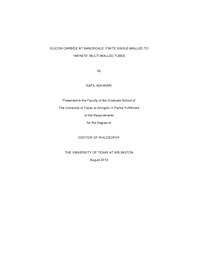
ATTENTION: The works hosted here are being migrated to a new repository that will consolidate resources, improve discoverability, and better show UTA's research impact on the global community. We will update authors as the migration progresses. Please see MavMatrix for more information.
Show simple item record
| dc.contributor.author | Adhikari, Kapil | en_US |
| dc.date.accessioned | 2013-03-20T19:11:29Z | |
| dc.date.available | 2013-03-20T19:11:29Z | |
| dc.date.issued | 2013-03-20 | |
| dc.date.submitted | January 2012 | en_US |
| dc.identifier.other | DISS-11827 | en_US |
| dc.identifier.uri | http://hdl.handle.net/10106/11541 | |
| dc.description.abstract | A systematic ab initio study of silicon carbide (SiC) nanostructures, especially finite single-walled, infinite double- and multi-walled nanotubes and nanocones is presented. Electronic and structural properties of all these nanostructures have been calculated using hybrid density functionals (B3LYP and PBE0) as implemented in the GAUSSIAN 03/09 suite of software. The unusual dependence of band gap of silicon carbide nanotubes (SiCNT) has been explained as a direct consequence of curvature effect on the ionicity of the bonds. The study of fullerene hemisphere capped, finite SiC nanotubes indicates that the carbon-capped SiC nanotubes are energetically more preferred than silicon-capped finite or hydrogen terminated infinite nanotubes. Capping a nanotube by fullerene hemisphere reduces its band gap. SiC nanocones have also been investigated as possible cap structures of nanotubes. Electronic properties of the nanocones are found to be strongly dependent upon their tip and edge structures, with possible interesting applications in surface science. Three types of double-walled SiCNTs (n, n)@(m, m) (3 n 6 ; 7 m 12) have been studied using the finite cluster approximation. The stabilities of these nanotubes are of the same order as those of the single-walled SiC nanotubes and it should be experimentally possible to synthesize both single-walled and double-walled SiC nanotubes. The binding energy per atom or the cohesive energy of the double-walled nanotubes depends not only on the number of atoms but also on the coupling of the constituent single-walled nanotubes and their types. A study of binding energies, Mulliken charges, density of states and HOMO-LUMO gaps has been performed for all nanotubes from (n, n)@(n+3,n+3) to (n, n)@(n+6, n+6) (n=3-6). Evolution of band gaps of the SiCNTs with increase in the number of walls has also been investigated. The nature of interaction between transition metal atoms and silicon carbide nanotubes with different curvature has also been investigated. The curvature of the nanotubes affects the nature of the interaction between the nanotubes and the transition teal atoms. Our study of functionalized SiCNTs by 3d transition metal atoms indicates that these nanostructures can have possible applications in spintronics and nano-magnetic storage | en_US |
| dc.description.sponsorship | Ray, Asok | en_US |
| dc.language.iso | en | en_US |
| dc.publisher | Physics | en_US |
| dc.title | Silicon Carbide At Nanoscale: Finite Single-walled To "infinite" Multi-walled Tubes | en_US |
| dc.type | Ph.D. | en_US |
| dc.contributor.committeeChair | Ray, Asok | en_US |
| dc.degree.department | Physics | en_US |
| dc.degree.discipline | Physics | en_US |
| dc.degree.grantor | University of Texas at Arlington | en_US |
| dc.degree.level | doctoral | en_US |
| dc.degree.name | Ph.D. | en_US |
Files in this item
- Name:
- Adhikari_uta_2502D_11827.pdf
- Size:
- 31.59Mb
- Format:
- PDF
This item appears in the following Collection(s)
Show simple item record


